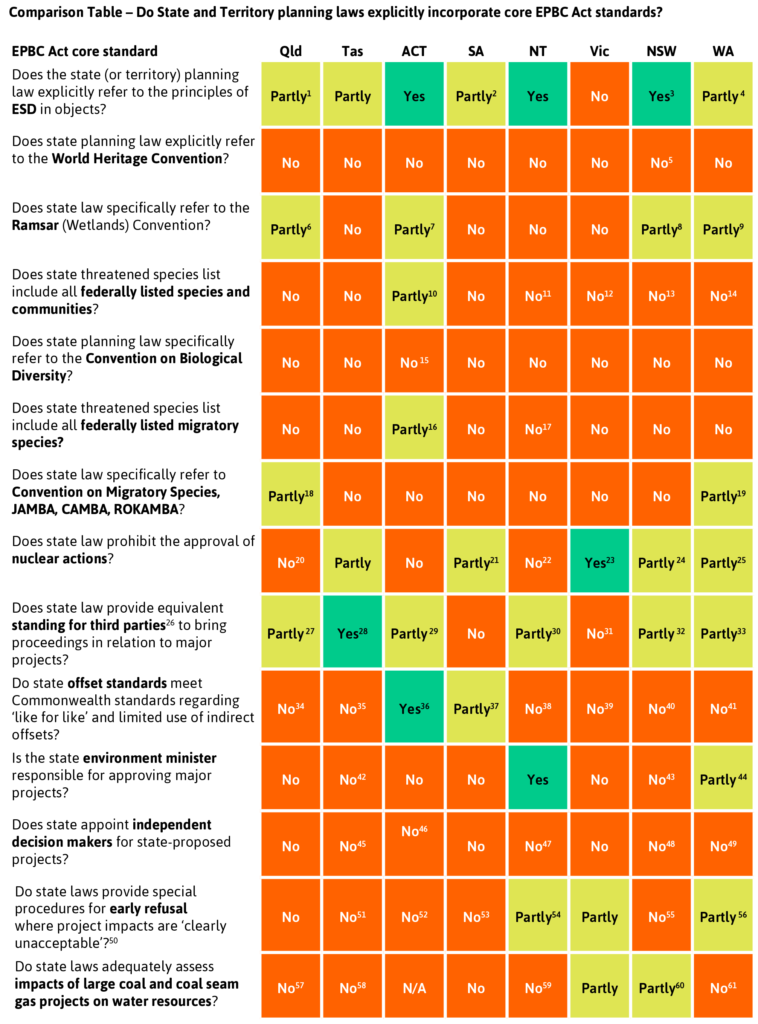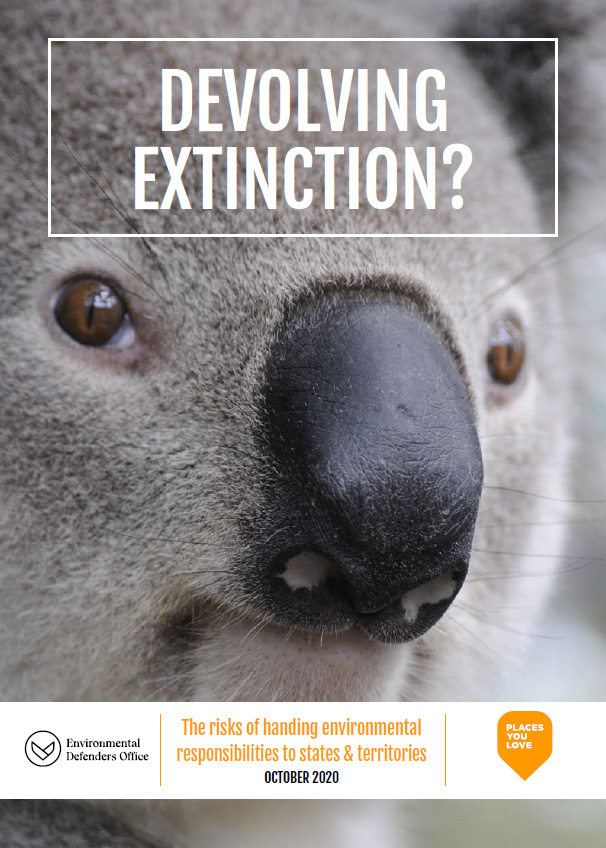The Australian Government is poised to hand over their national environmental approval responsibilities to states and territories, so the Places You Love alliance commissioned the Environmental Defenders Office to analyse whether state and territory laws can do the job.
The clear answer is no.
The Devolving Extinction? report is a damning audit of core standards in state and territory legislation and associated case studies, highlighting the need for comprehensive reform at all levels, and underscoring the importance of the Commonwealth in taking a leadership role in protecting and enhancing our unique environment for future generations.
The EPBC Amendment (Streamlining Environmental Approvals) Bill 2020 is being promoted by the Government as comprising minor technical amendments needed to facilitate the making of durable bilateral agreements between the Commonwealth and States and Territories to hand over environmental approval powers.
In fact, the implications of the Bill are far from minor and technical.
The proposal to devolve environmental responsibilities is not new and remains fraught with risk. In 2012 and 2014, the Places You Love alliance commissioned the Environmental Defenders Office to undertake audits of state and territory laws.
The conclusion of both audits was that no state or territory legislation met the full suite of existing national environmental standards required to protect matters of national environmental significance.
Given the re-appearance of the ‘one stop shop’ policy and the resurrection of the failed 2014 Bill, we have updated our audit analysis.
An updated review of state and territory laws shows the same conclusion – not only does no state or territory law meet current national standards, but in some jurisdictions, the environmental protections in state and territory laws have actually been weakened.
EDO has analysed case studies from across the country. This report includes the top 30 case studies that illustrate through actual examples how state and territory laws, processes and policies do not meet current national standards and do not provide assurance that environmental outcomes will be delivered under a system of devolved responsibilities. Common themes in the case studies provide evidence for the following conclusions:
- Does Commonwealth accreditation of state and territory laws deliver environmental outcomes? Mostly no.
- Can state and territory laws guarantee national standards will be implemented? No
- Do state and territory systems have independent assurance, compliance and enforcement (and deal effectively with conflicts of interest)? No
- Do state and territory laws adequately implement international obligations? No
- Do state and territory laws adequately address cumulative and cross boundary impacts? No
This audit of core standards in state and territory legislation (Part 1), combined with the case studies (Part 2), highlight the need for comprehensive legislative and governance reform at all levels, and the importance of the Commonwealth in taking a long-term leadership role to protect and enhance our unique environment for future generations.
Part One: Do state and territory laws address matters of national environmental significance?
The proposal that state and territory legislation can adequately address matters of national environmental significance is not supported by evidence in terms of delivery of environmental outcomes. A 2020 desktop analysis confirms the conclusion that no state or territory planning and environmental legislation adequately addresses the necessary suite of current national environmental standards.
State and territory laws are not designed to specifically address matters of national environmental significance, and this analysis confirms that the laws do not comprehensively address existing EPBC Act standards. It is clear that for state and territory laws to actually meet existing standards, law reform is already needed.
For state and territory laws to meet new national standards for environmental outcomes and assurance – as foreshadowed by the independent review process – there would need to be significant reform at the national, state and potentially regional and local levels. There would need to be both legislative reform, governance reform and significant resourcing at multiple levels to ensure that national standards were consistently applied and enforced on the ground at the project level. This analysis shows the scale of the reform task is substantial and should not be underestimated.

The report identifies 30 case studies from across Australia. The case studies document the environmental outcomes of Commonwealth accreditation of state and territory schemes such as Regional Forest Agreements and strategic assessments; include examples of where state and territories approved projects despite impacts on matters of national environmental significance; expose divergence of Commonwealth versus state standards – for example, for biodiversity offsets; demonstrate inaction on compliance and enforcement at the state level; identify limitations on current standards setting regimes – for example, NEPMs; expose the impacts of deregulation or weakened laws at a state level, for example in relation to land clearing; demonstrate the critical role of third party review and access to information; and provide specific examples of the failures of states and territories to implement international obligations, for example in relation to unique world heritage, Aboriginal cultural heritage, Ramsar wetlands, and migratory species.
- The Victorian RFA and Leadbeater’s Possum – Victoria
- The Melbourne Strategic Assessment – Victoria
- Carnaby’s cockatoos – Western Australia
- The Tasmanian RFA and the Swift Parrot – Tasmania
- Export Fisheries accreditation – Queensland
- Traveston Crossing Dam – Queensland
- Land clearing at Maryfield Station – Northern Territory
- Native vegetation management – Queensland (Kingvale)
- Biodiversity offsetting – NSW
- National Environment Protection Measure – Air Quality
- The Gorgon Gas Project – Western Australia
- Red tailed black cockatoo habitat burning – Victoria
- Manyana – Residential development in bushfire ravaged NSW
- Governance and conflicts of interest – Queensland
- Land clearing under self-assessable codes – NSW
- McArthur River Mine – Northern Territory
- Yeleerie Uranium – Western Australia
- Tourism in world heritage, Lake Malbena – Tasmania
- Shamrock Station irrigation project – Western Australia
- Warragamba Dam – NSW
- Shoalwater and Corio Bays Area – Queensland
- Juukan Caves and cultural heritage protection – Western Australia
- Four-wheel drive tracks and national heritage – Tasmania
- Great Barrier Reef Management – Queensland
- Toondah Harbour – Queensland
- National water management – South Australia and NSW
- Flying Foxes – Queensland
- Water storages and the Macquarie Marshes – NSW
- Olympic Dam mine expansion proposal – South Australia
- Koala protection – NSW






